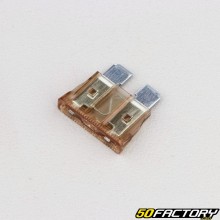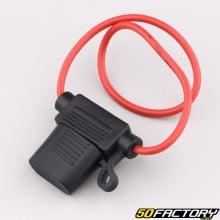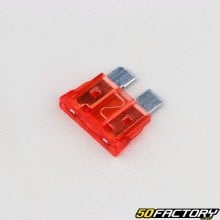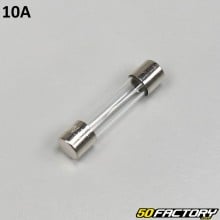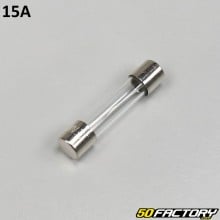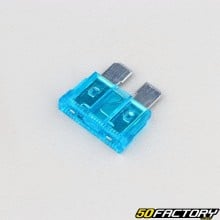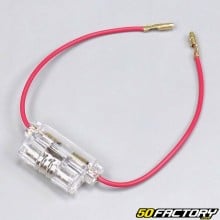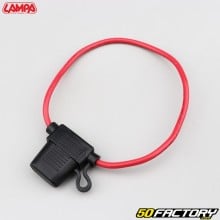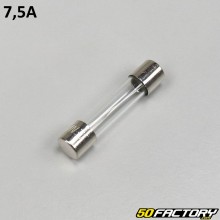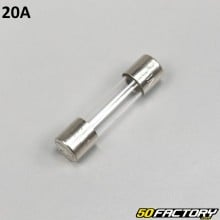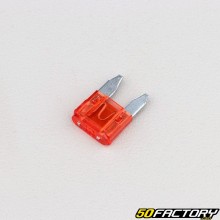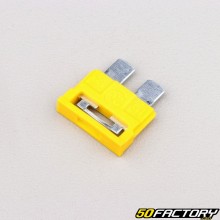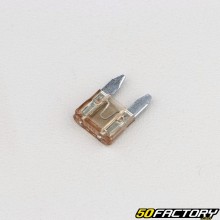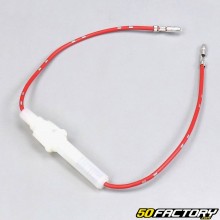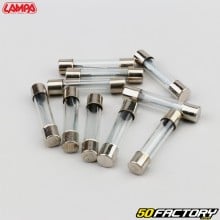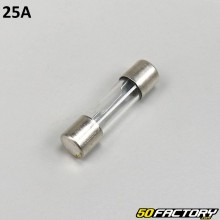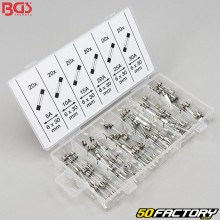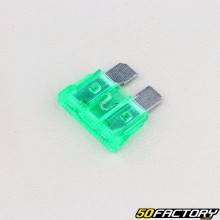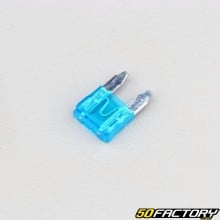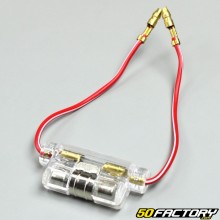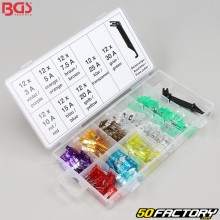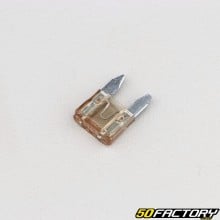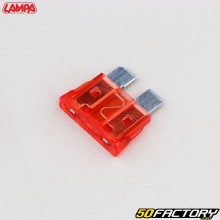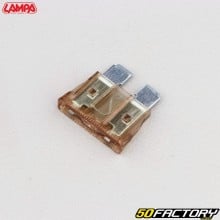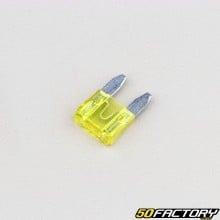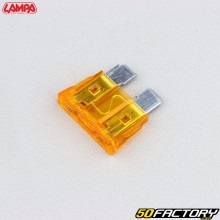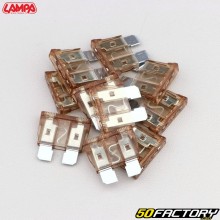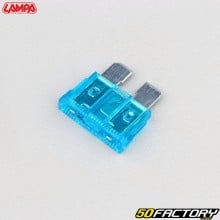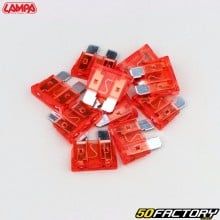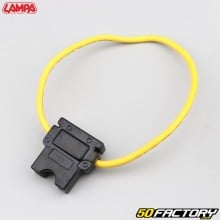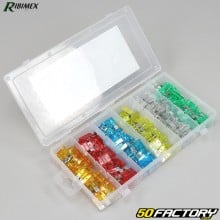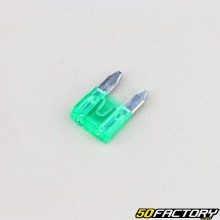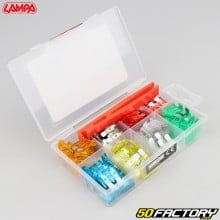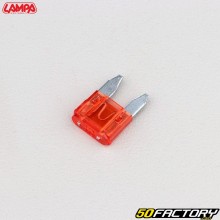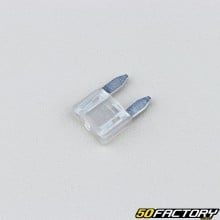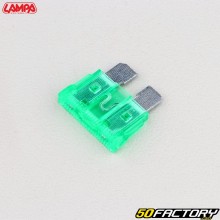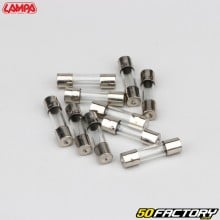 Fuse and fuse holder
Fuse and fuse holder
- IN STOCK0,80 €
- IN STOCK3,60 €
- IN STOCK0,80 €
- IN STOCK0,90 €
- IN STOCK0,90 €
- IN STOCK0,80 €
- IN STOCK4,00 €
- IN STOCK2,00 €
- IN STOCK0,90 €
- IN STOCK0,90 €
- IN STOCK0,80 €
- IN STOCK0,80 €
- IN STOCK0,90 €
- IN STOCK2,90 €
- IN STOCK1,50 €
- IN STOCK0,90 €
- IN STOCK13,60 €
- IN STOCK0,80 €
- IN STOCK0,90 €
-
- IN STOCK9,60 €
- IN STOCK0,80 €
- IN STOCK0,80 €
- IN STOCK0,80 €
- IN STOCK16,10 €
- IN STOCK0,90 €
- IN STOCK12,80 €
- IN STOCK1,70 €
- IN STOCK0,80 €
- IN STOCK10,70 €
- IN STOCK3,36 €
- IN STOCK0,80 €
- IN STOCK3,36 €
- IN STOCK1,80 €
- IN STOCK11,90 €
- IN STOCK0,90 €
- IN STOCK8,80 €
- IN STOCK0,90 €
- IN STOCK0,90 €
- IN STOCK3,36 €
- IN STOCK0,80 €
- IN STOCK1,40 €
Introduction to protection devices for two-wheelers and quads
The fuses, small, discreet but critically important components, are essential for the proper functioning of any vehicle. They are the safeguard of the electrical safety of your two-wheeler or quad. These small elements, often overlooked, play a determining role in protecting the electrical circuits of your means of transport. In the event of an overvoltage or short circuit, they sacrifice themselves to prevent the destruction of electronic devices or even a risk of fire.
As protectors of your electrical installation, these devices provide an essential function. They are the first line of defense against electrical damage that could compromise the performance of your vehicle. Without them, your electrical system would be exposed to a multitude of dangers, ranging from simple equipment failure to more serious situations like fires.
Whether you are a passionate motorcyclist or a professional, understanding the role of these safety elements and knowing how to manage them is essential. Embark with us in this practical guide to discover the fascinating world of protection devices and fuse holders, and to learn how these simple but robust components contribute to the performance and safety of your vehicle.
Understand how they work
A fuse is an element equipped with a filament and incorporated into an electrical circuit to ensure its protection. If an electrical overload occurs, this filament melts, interrupting the electrical flow and protecting the rest of the circuit from potential damage caused par this overload.
These security devices operate according to a simple but effective principle. They are designed to handle a certain amount of electricity, called amperage. When the current exceeds this amperage, the filament melts, interrupting the current and thus preventing excessive energy from damaging the circuit and its components. This is called “jumping” the device.
The jump of the latter is a physical phenomenon resulting from the conductivity property of the filament material. Typically, the latter is made of lead or a lead alloy, which melts at a relatively low temperature. When the current exceeds the capacity of the protection element, the heat generated melts the filament, thus interrupting the circuit.
The different types available
There are several types of these protective devices, classified according to their shape, size and ability to withstand a certain amperage. Some types are specific to cars, while others are intended for two-wheelers and quads. The two most common types are mini devices and standard devices. They vary in size, with the mini device being the smallest. The choice between these two will depend on the space available for housing these elements in your vehicle.
Blade fuses (ATS), mini blade fuses (ATM), low profile mini blade fuses (ATM-LP), maxi fuses (APX), low profile maxi blade fuses (APX-LP), etc. are the most common types.
Please check the specific fuse type needed for your vehicle.
The crucial role of these elements in your vehicle
Fuses are essential to the safety and performance of any vehicle. They protect both the internal electrical components of your two-wheeler or quad and the vehicle as a whole. In the event of a short circuit or overload, they prevent overheating of electrical wires which could lead to a fire. In addition, by protecting electrical components from overload, they contribute to their longevity, thus optimizing the performance of your vehicle.
These safety devices are therefore real guardians of your vehicle, ensuring its proper functioning and safety. Their importance should therefore not be underestimated,ar A defective or unsuitable device can have serious consequences on the entire electrical system of your vehicle.
Choose the element suitable for your vehicle
Selecting the right protection device for your vehicle is not a task to be taken lightly. An incorrect choice can either not properly protect your electrical components or interrupt the normal operation of your machine. Two criteria must be considered when choosing this element: color and amperage.
Interpretation of colors and amperages
They are classified according to color and associated amperage. Colors may vary from gray, purple, pink, tan, brown, red, blue, yellow to green. The amperages, for their part, can vary from 2 to 30. Par For example, a red model generally has an amperage of 10, while a yellow model has an amperage of 20. This is how you determine the protection device you need depending on the type of vehicle and device you are using. you possess. Replacing a fuse requires the use of a fuse with the same rating to ensure adequate protection of the electrical circuit.
Consult our guide on range of fuses
Installation and replacement
Installing or replacing an electrical protection component on your two-wheeler or quad is a task that can be accomplished par yourself, provided you have the right information and tools. This may seem intimidating at first, but with a little patience and practice, it becomes a fairly simple task. Before any handling, always remember to disconnect the battery from your vehicle to avoid any risk of electrocution or short circuit.
Preparation for handling
Start par Equip yourself with an electrical protection component extraction tool. It is a small pliers specially designed to facilitate the removal of fuses. To work safely, wear protective glasses and insulated gloves. Next, identify your fuse box. Check your vehicle's manual or search online if you don't know where it is located. Every vehicle is different, so make sure you have the right information for yours.
How to check an item?
Verifying an electrical protection component is done in two steps. First, you need to find the fuse holder. This is usually located under the saddle of your two-wheeler, but it can also be located near the battery on certain models. Once the fuse holder has been found, simply remove each element in turn and examine the filament through the transparent face. If the filament is broken, this indicates that the fuse has blown and must be replaced.
Procedure for replacing an element
Replacing an item is simple. Simply carefully remove the worn element from the fuse holder and insert the new one, respecting the necessary amperage. Be careful though, a fuse that blows regularly is often a sign of a larger electrical problem. In this case, it is recommended to have your vehicle inspected par a professional.
After installation
Once the new component is inserted, check its installation by operating the electrical element it protects. If everything works normally, congratulations, you have successfully installed your fuse. If you experience persistent problems, do not hesitate to consult a professional.
Fuse holders: an equally essential element
The support, often overlooked, plays a role just as crucial as the protective element itself. It guarantees that it is properly maintained in the electrical circuit, and acts as a support to facilitate its installation and extraction. Thanks to this device, it is possible to change a component easily and without risking damaging the electrical circuit. There are different types of supports, the choice of which essentially depends on the type of protection required.ar your two-wheeler or quad.
Taking care of your fuse holders: a guarantee of durability for your vehicle
As with protective elements, choosing the right support is essential to ensure optimal protection and durability of your electrical circuit. These components are made from robust and durable materials to resist vibrations, shocks and temperature variations, which contributes to the longevity of your vehicle. They are also designed to be easy to install, with simple locking and unlocking mechanisms for easy and safe replacement of the protective element.
Choosing the right fuse holder for your needs
Each vehicle may require a different type of holder, depending on the fuse size and specifications. The fuse holders are distinguished par their format (mini, standard, maxi), their capacity (single, double) or their method of fixing (screw, clip). It is therefore important to clearly identify your needs before choosing the appropriate support, to ensure effective protection of your electrical circuit.
Conclusion: The importance of these components for the safety and performance of your vehicle
In conclusion, these electrical protection devices and their supports play a critical role in the safety and performance of your vehicle. They protect your two-wheeler or quad from possible overloads or short circuits, and avoid high repair costs. Whether it's preventing fires or optimizing your vehicle's performance, the importance of these small components should not be undermined.
However, the importance of these security features goes beyond simple protection. They are like insurance for your vehicle, ensuring that your two-wheeler or quad continues to perform optimally, even in the event of an unexpected power surge. They provide peace of mind, knowing that your vehicle is protected against potential electrical damage.
Additionally, it is essential to understand that choosing the right fuse can have a significant impact on the lifespan of your vehicle. A properly chosen and installed electrical protection device helps balance the electrical load, ensuring a longer lifespan for your electrical components.

























